Star Turn Finding Ourselves in the Dinaledi Chamber
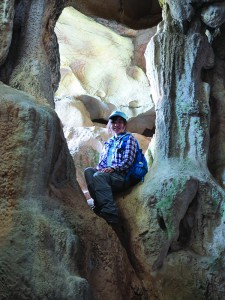 Pianpian Wei (above), a PhD candidate in paleoanthropology at the Chinese Academy of Sciences, was one of some forty scientists responsible for researching the bones of a previously unknown species of hominin from the Rising Star cave system in South Africa.
Pianpian Wei (above), a PhD candidate in paleoanthropology at the Chinese Academy of Sciences, was one of some forty scientists responsible for researching the bones of a previously unknown species of hominin from the Rising Star cave system in South Africa. SINCE LONG BEFORE the oldest physical creations in human culture—the raising of the step pyramid at Saqqara or the Great Wall of China, for example—people have been telling stories of human origins. Through religion, such explanations have become creation myths, sacred genealogies, epic tales, and pious platitudes (e.g., “you are a child of God”).
With the publication of Charles Darwin’s The Descent of Man in 1871, a rival explanation took shape. We are animals, it said, of the genus Homo, which split from Pan (chimpanzees) some seven million years ago and wandered through a hominin lineage that walked upright, made use of fire, lost its brow ridge and body hair, and at long last became us: members of the uniquely communicative, collaborative, and inventive species Homo sapiens sapiens—the doubly wise ones.
But does science have its story straight?
Typically, as science advances, uncertainty shrinks. In recent years, however, the scientific narrative of our origins has grown increasingly hazy. Consensus on the date of the human-chimpanzee split has shattered. Some have pushed the date back to as much as thirteen million years ago; others have reeled it in to six million years, and a much cited 2006 article in the journal Nature claims genetic evidence for repeated episodes of interbreeding rather than any definitive split.
The post-split tracks have also been muddied. Early anthropologists conceived of an evolutionary lineage leading to modern humans. We have since learned that many kinds of hominin have walked the earth. Some, like the Neanderthals and the recently discovered Denisovans, both competed and interbred with our ancestors before falling to the scythe of natural selection. Others like Homo floresiensis, better known as “the Hobbit” species, remain an enigma.
Now, an astonishing find in the Rising Star caverns of South Africa has touched off an explosion of new questions and controversies.
In a nearly inaccessible chamber at the back of a tortuous cave system, a mysterious trove of fossils lay undisturbed for unknown ages, until a couple of cavers found it in 2013.
“It is the most significant and extensive discovery of early human…fossils ever made on the continent of Africa,” Lee Berger, head of the team that found them, told British television. He’s not exaggerating. So far fifteen nearly complete individuals of an entirely new hominin species have been recovered. More than 1,500 fossils have come out of the chamber, and no one knows how many more remain to be discovered. The fossil remains span all ages, with peaks among the elderly and the very young.
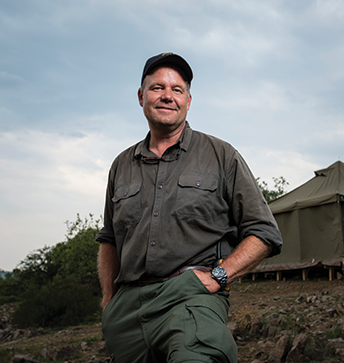
Lee Berger
All the fossils are similar to each other and different from other known hominin species. Like a child’s split-page flipbook, they combine some human-like features with some very apelike features.
Homo naledi (named after the cave where it was found) has humanlike hands and feet and facial features approaching ours, but has a small head and an apelike trunk. Its fingers are more curved than a modern human’s and its shoulders more rounded, indicating that it was a climber. However, its feet are nearly identical to ours, suggesting that it was also an accomplished upright walker. This pattern holds down to the smallest details.
“When you look at those teeth, you realize that they are not [from] modern humans,” paleoanthropologist Charles Musiba of the University of Colorado-Denver said in a televised interview. “They have some features transitional between modern humans and some of our earliest ancestors.”
The most astonishing aspect of the find, however, is not anatomical but implicit. The space where the fossils lay appears to be a burial vault. All the evidence suggests that these primitive creatures with brains the size of an orange took pains to haul their dead through the cave and deposit them in what is now called the Dinaledi Chamber (“chamber of stars”).
The discovery of Homo naledi has been hailed as a “missing link” and scorned as a triumph of showmanship over science. But most of all, it has rekindled that eternal question: who are we?

THE TALE OF DISCOVERY has been told—and shown—but it bears a brief retelling. In 2013, two slim and brave South Africans were scouting one of many unexplored caverns near the Cradle of Humankind, a World Heritage Site northwest of Johannesburg, in a region that has produced more than a third of all discovered ancestral fossils.
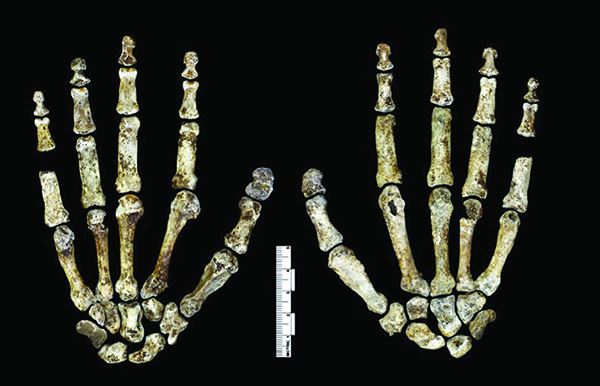 Having scaled a wall at what he thought was the back of the cave, Rick Hunter shifted to make room for his partner, Steve Tucker. Suddenly, like Alice, Rick slithered down a hole into a wonderland. The narrow, twisting passage led to a hidden chamber littered with fossils—hominin fossils, whole hominin fossils, and almost nothing but hominin fossils. (Note: “hominin” is a recent term that denotes a strictly human ancestral lineage, as distinguished from the larger family of closely related primates that includes chimps, orangutans, and gorillas, whose ancestral members are termed “hominids.”)
Having scaled a wall at what he thought was the back of the cave, Rick Hunter shifted to make room for his partner, Steve Tucker. Suddenly, like Alice, Rick slithered down a hole into a wonderland. The narrow, twisting passage led to a hidden chamber littered with fossils—hominin fossils, whole hominin fossils, and almost nothing but hominin fossils. (Note: “hominin” is a recent term that denotes a strictly human ancestral lineage, as distinguished from the larger family of closely related primates that includes chimps, orangutans, and gorillas, whose ancestral members are termed “hominids.”)
Fortunately, when Hunter dropped into the unsuspected grotto, he had a helmet camera running. Hunter was part of a network of amateur explorers who were paid to report any promising finds to the aforemetioned Berger, (pictured below), an American paleontologist based at South Africa’s famed University of Witwatersrand. So, when Hunter stumbled upon what turned out to be a new species in the human ancestral family, his discovery was recorded for posterity.
Within hours, images from the cave had Berger sputtering and cursing with excitement. “I was at home at night when the doorbell rang,” Berger recalled in a podcast. “There was Pedro [Boshoff, his former student]. He came in with Steve and Rick in tow, and they opened up a laptop, and there was a picture of a jawbone with these beautiful teeth that I could immediately tell were from a very primitive or ancient hominid.”
In the world of paleontology, to find a fossilized fingertip or tooth is cause for joy; here, in plain view, were a jaw, a skull, and signs of much more to come. “We don’t see fossils like that in South Africa,” Berger said. “I was stunned.”
Of course, even then he had no idea just how remarkable the find would prove to be. But right away there was a problem: Berger is a big man, and the sinuous passage to the chamber narrows to barely seven inches wide at one point.
For a paleontologist to pass on the thrill of discovery must have been like asking an astronaut to give up his seat on a journey to the moon. It took Berger until the early hours of the next morning to accept that he needed help. “History would never forgive me if I didn’t act right then,” he recalled.
Berger turned to a quintessential twenty-first century tool: Facebook. He put out a worldwide call for “skinny scientists who are not claustrophobic,” as he later put it. The response was staggering. Of the fifty-seven plausible candidates, Berger selected six—all, as it happened, were women. This marked the first time that an all-female team led a major scientific expedition.
Two completely different evolutionary trends fed into that first. During several million years of evolution, violent male competition for reproductive access to women has resulted in sexual dimorphism. In other words, your average male paleontologist is beefier than his female counterpart. A much more recent trend in social evolution came into play as well: women now make up a greater percentage of those going into higher education in North America and since 2008 have earned the majority of doctoral degrees (52.2 percent in 2012). And so, most of the applications Berger received came from women.
Among them was a Canadian rock-climber and doctoral candidate in physical anthropology named Marina Elliott. Berger’s Facebook call changed her life. She recalled her supervisor passing along the post and remarking casually, “I don’t suppose you have caving experience?”
“As it turns out I had,” Elliott said in an interview for this story. “I had been a recreational sport climber for many years and also spent a number of years caving in the Rockies in Canada, where I’m from. I tried for it and had a Skype interview with Lee Berger, and within a month I had landed in South Africa and was starting to excavate.”
Elliott became the first scientist to enter the chamber. Her heart was pounding, partly out of anticipation and partly because the passage is dark, rugged, and, even for an experienced caver, terrifying. But as she dropped into Dinaledi, her view instantly changed.
“It was a sea of bone,” she recalled.

HAVING WOMEN IN THE LEAD was just one of several novel features of the Dinaledi dig. Another was the highly public reveal of the team’s findings.
By a happy coincidence, when Hunter and Tucker made their find in 2013, NOVA, the PBS science series, had a team in the area preparing a documentary about Berger, who, five years earlier, had discovered an ancestral species he named Australopithecus sediba. That find, though largely overlooked by mainstream paleontology, had been intriguing enough to prompt NOVA to begin filming a special called “Dawn of Humanity.” As a result, the species found in Rising Star, Homo naledi, was presented to the scientific community and the public on the very same day.
On September 10, 2015, as a peer-reviewed paper went live on the online journal eLife, NOVA released a nearly two-hour long special on Berger, his team, and the Rising Star discovery. Science doesn’t usually work that way. Indeed, it’s hard to think of an exact parallel. The 1969 moon landing comes close, but of course that had been planned since President Kennedy made his famous moonshot speech in 1961. The discovery at Rising Star and its end-to-end coverage were entirely serendipitous.
Yet another novelty: the team not only published the usual article with photos and figures, but simultaneously released a podcast and 3-D scans of their fossils—giving free access to anyone. This has meant far more public attention to a scholarly site than usual.
“We really wanted to make a statement about access to material and access to information,” Elliott said. The strategy has worked. According to Google Trends, Homo naledi is the most popular search term in the genus since Homo floresiensis in 2005. What’s more, release of the 3-D scans has brought about another novelty: teachers and researchers all over the world are downloading them and building precise fossil replicas with 3-D printers.
John Hawks, distinguished professor of paleoanthro-pology at the University of Wisconsin-Madison and a member of Berger’s team, finds this bracing. “Human origins is a field in which the people who study fossils often seem very secretive,” he remarked on his blog. “Now for the first time, people are downloading and handling fossils at the moment they are published.”

NOT EVERYONE is so impressed. The man in charge and his means of communication have only amplified the debate. Prior to this discovery, Berger had already courted controversy for dissing Mary and Louis Leakey’s big find: the “handyman”—Homo habilis, the supposed transitional species between Australopithecus and Homo (the genus of our species). Louis Leakey defined habilis as human not because of anatomical features—there is no complete skeleton of the creature—but because it was found with primitive tools.
Since the 1990s, however, it has been clear that tool use is not an exclusively human trait, and that the use of tools goes back long before the era of Homo habilis. This has led Berger and others to question whether habilis is a defined species, let alone an ancestral one. Instead, Berger has promoted his own prior find, Australopithecus sediba.
That, in turn, has drawn considerable criticism, which has only been amplified by the Rising Star find. Carol Ward, the distinguished professor of biological anthropology at the University of Missouri, is among those who aren’t entirely happy with the glitzy debut of Homo naledi. “[As] one of my colleagues said, at this point this is just a curiosity,” Ward remarked in an interview for this story. “The paper they published was very light on details. …We have no information on the depositional context of the fossils, because they went and pulled fossils out, but that was before anybody thought to try to figure out exactly how they got there.”
Ward acknowledges that it is notoriously difficult to date fossils in the South African caves. But that’s precisely why, in her view, all the razzmatazz is premature. “Most scholars take longer to do the analysis and present data to support the conclusions when they publish, and so far this has not been done,” she said. “The media fanfare is a fanfare but…when they get dates we’ll know what they mean.” She is particularly withering about Berger’s choice of journal for the debut of the discovery. “It was published in this eLife journal, which is not run by people in the field,” she said. “So technically, yes, it was peer-reviewed, but the most knowledgeable people had not seen that paper beforehand.”
Such criticism makes Hawks scoff. “I find that so incredible,” he told me, noting that at sixty-plus pages, the eLife article is almost ten times more than is usually published about a new species. He went on to accuse critics of belonging to a sort of anthropology club of insiders. “The club is not used to thinking about openness in publishing,” he said. “This is so huge and transformative. We cannot get from the glamour journals the kind of space and openness that we are guaranteed with eLife.”
Elliott also defended the choice of the online journal. “What we really wanted to do was make a statement about access to material and access to information. Humans tend to fear that which they don’t understand, and so for us as scientists to not encourage the public to engage with this material would actually perpetuate some of the problems that we’re seeing in North America, with very polarized attitudes toward scientists and towards human origins research.”
However, Ward is far from alone in leveling criticisms. In a field where it’s not unusual to analyze a find for a decade before publishing, many feel that the NOVA deadline prompted Berger to hasty publication. Some even suggest that the fossils were damaged during the swift extractions. “Rushing things, in particular to suit filmmakers, is very dangerous,” paleontologist Tim White of the University of California, Berkeley, told the Guardian newspaper.

OF ALL THE MYSTERIES that cling to the Dinaledi Chamber, the most profound concerns how the bones got there. Berger and his team infer that Homo naledi buried their dead. That is an astonishing behavior for a species that appears to be small-brained and primitive, and many experts in the field are not ready to accept it. Nevertheless, all evidence to date points to that conclusion.
Hawks reeled off the reasons why he and others on the team are convinced of their claim. “There’s no sign of a toothmark on them,” he noted. “So, the predator hypothesis is out.” The soils indicate that the chamber has always been closed, and that water did not carry bodies into the chamber.
“We know that the bodies entered the chamber whole. Things that early on in decomposition become disassociated are found together, he said, adding, “It’s only Homo naledi bodies; it’s not anything else, and we can show that they didn’t fall in there.”
It’s also clear that they didn’t live in the chamber. Bodies of all ages are found there, so it wasn’t a band of explorers. These creatures were smaller and better adapted to climbing than modern humans, so it’s unlikely that they got stuck. What’s more, soil levels indicate that bodies were deposited at different times.
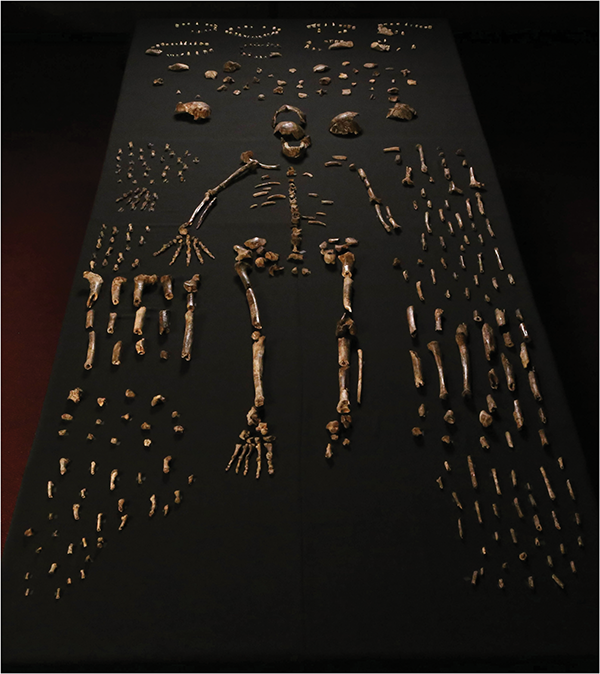 “All the easy explanations that do work at other South African sites we can rule out,” Hawks concluded. And for him, it’s not unthinkable that Homo naledi buried its dead.
“All the easy explanations that do work at other South African sites we can rule out,” Hawks concluded. And for him, it’s not unthinkable that Homo naledi buried its dead.
“Social mammals know other individuals, they have emotion. We know that other animals feel grief when members of their group die….We know that sometimes they will carry the bodies of the dead. Chimpanzees will carry their dead for days,” he noted. “What I see in Homo naledi is that they are taking a basic ability that we share with most social animals and they are adding to it an element of cultural knowledge, a practice that says: when an individual dies we don’t just let them be exposed to the elements, we take them to this place.”
So, who are we? If there’s one thing that the discovery of Homo naledi has brought to light it is this: we are a quarrelsome species. To put it more precisely, we have evolved to form tight-knit collaborative bands that war, literally or figuratively, against one another. The scientific process is yet one more fractal turn in that universal human pattern—science thrives on teamwork and harsh criticism.
But if science vindicates the controversial idea that Homo naledi was an ancestral species which buried its dead, there is another lesson to draw. Humanity has taken grief, an emotion shared with many animals, and evolved it into the social behavior we call compassion. This brings to mind the philosopher Schopenhauer, who wrote “To be unsociable…is a great piece of good fortune, because almost all our sufferings have to do with other people.”
That is surely true. But Schopenhauer failed to see that the ability to translate empathy, grief, outrage, and other emotions into social action eventually led to legislatures, laws, and institutions of justice that, however grossly imperfect, have made life immeasurably better than it was during the war of all against all. Over the span of civilization, the circle of our compassion has gradually, haltingly grown, and now, looking back, we can glimpse a debt of gratitude that we may owe to Homo naledi.
Are we, as once thought, “man, the hunter,” “man, the toolmaker,” or “human, the culture creator”? No. None of those makes us unique. But perhaps we are the creature that put compassion into action and so remade the world.

Rising Star: An Interview with Marina Elliott
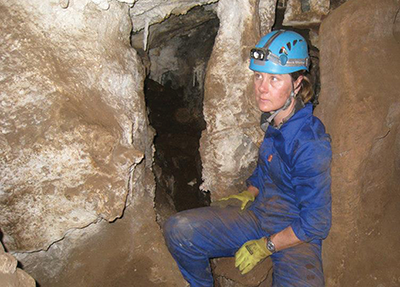 By Clay Farris Naff
By Clay Farris Naff
Marina Elliott (right) is a biological anthropologist, a postdoctoral fellow at the University of the Witwatersrand in South Africa, and a member of the Rising Star Expedition located in the Cradle of Humankind in South Africa. She was the first scientist to enter the Dinaledi Chamber inside the Rising Star Cave and was part of an all-female team responsible for retrieving the fossils that lay within it.
Q. In the fall of 2013, you were finishing a PhD at Simon Fraser University in Canada when you had a Skype interview with Lee Berger. You were soon hired to be part of his excavation team, but neither of you really knew what you were going to find, right?
A. Not really. When I spoke to Lee at the beginning he thought we’d be going after a single skeleton—more like a salvage operation than anything else. We all thought that at the beginning. Within the first day or two we realized we were dealing with something quite different.
Q. What did it feel like to be the first scientist to enter a chamber whose significance will probably never be forgotten?
A. At the time I wasn’t thinking about the significance. It was very exciting and obviously a little bit scary. The route to the actual expedition is very physical and a little bit—or rather, a lot—dangerous. Passing through the final squeeze into the area where the bones were was thrilling. At the time I likened it to what Howard Carter must have felt like when he entered Tutankhamun’s tomb: a mixture of excitement and sheer wonder. Everywhere I looked I could see bones on the surface and obviously more underneath. It was pretty mind-blowing.
Q. For those of us who haven’t done this sort of thing, give us a sense of just how unusual it is to find that many bones in one spot.
A. It’s extraordinary. In archeology, where we’re used to dealing with modern human remains, volumes of this kind are not uncommon. But in paleoanthropology we’re historically used to working with very fragmentary material: a jaw here, a piece of skull there. For a paleoanthropologist to be confronted with more than 1500 fragments after just a month’s excavation is pretty incredible.
Q. It’s still less than a month since the first journal article appeared and the airing of a major NOVA production. What’s it all been like?
A. Public interest in the project has been fantastic, and I think that’s in large part due to the fact that we went with open access publishing. That was very deliberate. This is African national heritage and world heritage, so I think it’s really important for people to understand and think about and learn from this material. We’re really committed to people engaging with science at a very direct level, whether they’re scientists or not. For us it was very gratifying to see people interested in the project and the material and actually reading the professional article.
In terms of the anthropology community, obviously the whole point of science is that you’re never going to always agree on everything, and a certain amount of respectful discourse is welcome. I think it’s healthy for scientists to disagree and provide their own evidence for what they think is going on. And that’s part of the open access model as well. People can download the files and see the fossils themselves. The articles are readily available to professional anthropologists and lay people. If they don’t agree with what we said or the hypotheses we put forward, there is a forum for talking about that and testing those ideas. Overwhelmingly, the response has been very positive. We basically started the conversation.
Q. Some have said that releasing a documentary on the same day as your paper amounts to grandstanding or perhaps an attempt to blunt skepticism with public acclaim. Has any of that reached you and do you have any response?
A. The NOVA special had been in the works for more than two years before the Rising Star cave was found. When Rising Star happened, Lee and the people making the documentary said, “We have to try to incorporate this.” It is exceptional material and really worth sharing with people. So, yes, it’s early in the project, but the science will go on regardless. Like the open-access model, it encourages people to actually engage with the science and learn about it firsthand, and I think that’s invaluable.
Q. I don’t want this next question to sound in any sense discounting of what you did, but I want to ask whether it meant anything special as a woman to be the first scientist to enter the cave. This point was made in the documentary and it certainly was made in some of the press. Do you see that as a positive, an irrelevance, or an annoyance?
A. We get this a lot, and to me it really is a double-edged sword. I’m very proud to be a female scientist, and I’m very proud of my participation in the project. It was a real honor and a privilege to be chosen as the first individual to enter the cave. But being a female scientist in a high-risk environment shouldn’t be an issue. We still have some work to do in terms of ensuring that something like this doesn’t raise eyebrows. I am very encouraging of young women in the sciences and in exploration. We all have skill sets that differ, and we should be given an equal opportunity to express those. This applies equally to young boys.
Q. If there’s one thing everybody agrees on, it’s that dating the remains is a critical task. Are there efforts underway to do that?
A. We have tried over the last two years to get dates that are reliable and repeatable. One of the disadvantages we face is that there aren’t any other animals in the chamber that we can correlate with. The chemical dating methods used in South Africa to date have not given us consistent answers, and we don’t have things like volcanic layers to track with the way they can in East Africa. We definitely are going to keep trying.
Q. What are the implications of dating this find?
A. In terms of looking at where this population lies on the human family tree—if they are direct or a side branch—the morphology is not dependent on the date. Obviously, a date is very important, so if it is five million years old versus 500,000, the implications for behavior and morphology differ. But for the initial analysis I don’t really think we need a date at this point.
One thing this find reinforces is that we have so much more to learn about our own origins. We really don’t know what we thought we knew. A lot of people get to a point where they think everything’s been discovered. That’s not true; exploration is still fundamentally important.
